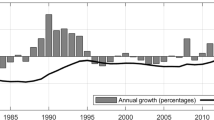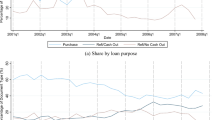Abstract
We study the potential model instability problem with respect to mortgage default risk and examine to what extent it helps explain the default shock during the recent crisis. We find that econometric default risk models based on historical data can be unstable over time. Due to temporal shifts in the parameters, default prediction of the 2006 vintage subprime loans based on hazard and Logit models estimated with 2003 vintage loan data can generate over 40% fewer defaults than the actual number, assuming perfect forecast of house price change. We also find that the combined impact of parameter instability and bad forecast of HPI enlarges the under-prediction of default rate but the marginal impact of parameter instability is larger than that of bad HPI forecast. Our findings have important implications regarding model limitations and risk, model improvements, economic capital, and regulatory reform.



Similar content being viewed by others
Notes
Major mortgage investors had to substantially write down their mortgage assets and rating agencies had to adjust their ratings of mortgage-related securities to reflect revised expectations of default losses. Many mortgage lenders went into bankruptcy due to unexpected losses.
“CDO Boom Masks Subprime Losses, Abetted by S&P, Moody’s, Fitch,” Bloomberg News, May 31, 2007.
“The Financial Crisis and the Role of Federal Regulators,” the House Committee on Oversight and Government Reform hearing on October 23, 2008.
For example, lenders made important changes in response to pressure on revealed redlining practice and Fannie Mae revised standards on ARMs based on academic studies (Vandell 1993).
Notice that the loan duration time T is different from the natural time t, which allows identification of the model.
The regression results are available upon request.
A large fraction of the subprime mortgage loans are ARMs, e.g. about 38 percent of the LP sample are 2/28 ARMs.
10-year Treasury rate for FRM 30 and 7-year Treasury rate for FRM 15.
Those predictions together with scenario analysis and sensitivity analysis are then used to assist mortgage underwriting, pricing and risk management.
We set the insignificant parameters to zero because they are statistically indifferent from zero.
References
Agarwal, S., Ambrose, B. W., Chomsisengphet, S., & Sanders, A. B. (2009). The neighbor’s mortgage: Does living in a subprime neighborhood impact your probability of default? SSRN working paper.
Alexander, W. P., Grimshaw, S. D., McQueen, G. R., & Slade, B. A. (2002). Some loans are more equal than others: third-party originations and defaults in the subprime mortgage industry. Real Estate Economics, 30(4), 667–697.
Ambrose, B. W., & Sanders, A. B. (2003). Commercial mortgage backed securities: prepayment and default. Journal of Real Estate Finance and Economics, 26(2/3), 179–196.
An, X., Deng, Y., & Sanders, A. B. (2009). Default risk of CMBS loans: What explains the regional variations? National University of Singapore, IRES Working Paper 2009–009.
An, X., Clapp, J. C., & Deng, Y. (2010a). Omitted mobility characteristics and property market dynamics: application to mortgage termination. Journal of Real Estate Finance and Economics, 41(3).
An, X., Deng, Y., & Gabriel, S. A. (2010b). Asymmetric information, adverse selection, and the pricing of CMBS. Journal of Financial Economics, forthcoming.
Andrews, D. W., & Fair, R. C. (1988). Inference in nonlinear econometric models with structural change. Review of Economic Studies, 55, 615–640.
Archer, W. R., Ling, D. C., & McGill, G. A. (1996). The effect of income and collateral constraints on residential mortgage terminations. Regional Science and Urban Economics, 26, 235–261.
Archer, W. R., Ling, D. C., & McGill, G. A. (1997). Demographic versus option-driven mortgage terminations. Journal of Housing Economics, 6(2), 137–163.
Calhoun, C., & Deng, Y. (2002). A dynamic analysis of fixed- and adjustable-rate mortgage terminations. Journal of Real Estate Finance and Economics, 24, 9–33.
Campbell, T., & Dietrich, J. K. (1983). The determinants of default on conventional residential mortgages. Journal of Finance, 48(5), 1569–1581.
Capozza, D. R., Kazarian, D., & Thomson, T. A. (1997). Mortgage default in local markets. Real Estate Economics, 25(4), 631–655.
Capozza, D. R., Kazarian, D., & Thomson, T. A. (1998). The conditional probability of mortgage default. Real Estate Economics, 26(3), 359–390.
Chen, J., & Deng, Y. (2003). Commercial mortgage workout strategy and conditional default probability: Evidence from special serviced CMBS loans. USC Lusk Center for Real Estate Working Paper, 2003–1008.
Ciochetti, B. A., Deng, Y., Lee, G., Shilling, J., & Yao, R. (2003). A proportional hazards model of commercial mortgage default with originator bias. Journal of Real Estate Finance and Economics, 27(1), 5–23.
Clapp, J. C., Goldberg, G. M., Harding, J. P., & LaCour-Little, M. (2001). Movers and shuckers: interdependent prepayment decisions. Real Estate Economics, 29(3), 411–450.
Clapp, J. M., Deng, Y., & An, X. (2006). Unobserved heterogeneity in models of competing mortgage termination risks. Real Estate Economics, 34(2), 243–273.
Clauretie, T. M. (1987). The impact of interstate foreclosure cost differences and the value of mortgages on default rates. Journal of the American Real Estate and Urban Economics Association, 15(3), 152–167.
Cunningham, D. F., & Capone, C. A., Jr. (1990). The relative termination experience of adjustable to fixed-rate mortgages. Journal of Finance, 45(5), 1687–1703.
Demyanyk, Y. S., & Van Hemert, O. (2009). Understanding the subprime mortgage crisis. Review of Financial Studies, forthcoming.
Deng, Y. (1997). Mortgage termination: an empirical hazard model with stochastic term structure. Journal of Real Estate Finance and Economics, 14(3), 309–331.
Deng, Y., & Quigley, J. M. (2002). Woodhead behavior and the pricing of residential mortgages. Lusk Center for Real Estate Working Paper, No. 2001–1005.
Deng, Y., & Gabriel, S. A. (2006). Risk-based pricing and the enhancement of mortgage credit availability among underserved and higher credit-risk populations. Journal of Money, Credit and Banking, 38(6), 1431–1460.
Deng, Y., Quigley, J. M., & Van Order, R. (1996). Mortgage default and low down-payment loans: the cost of public subsidy. Regional Science and Urban Economics, 26, 263–285.
Deng, Y., Quigley, J. M., & Van Order, R. (2000). Mortgage terminations, heterogeneity and the exercise of mortgage options. Econometrica, 68(2), 275–307.
Elul, R. (2009). Securitization and mortgage default: reputation vs. adverse selection. SSRN working paper.
Episcopos, A., Pericli, A., & Hu, J. (1998). Commercial mortgage default: a comparison of logit with radial basis function networks. Journal of Real Estate Finance and Economics, 17(2), 163–178.
Feldman, D., & Gross, S. (2005). Mortgage default: classification trees analysis. Journal of Real Estate Finance and Economics, 30(4), 369–396.
Follain, J., & Struyk, R. (1977). Homeownership effects of alternative mortgage instruments. Journal of the American Real Estate and Urban Economics Association, 5(1), 1–43.
Foster, C., & Van Order, R. (1984). An option-based model of mortgage default. Housing Finance Review, 3(4), 351–372.
Foster, C., & Van Order, R. (1985). FHA terminations: a prelude to rational mortgage pricing. Journal of the American Real Estate and Urban Economics Association, 13, 292–316.
Gerardi, K., Shapiro, A. H., & Willen, P. S. (2008). Subprime outcomes: Risky mortgages, homeownership experiences, and foreclosures. Federal Reserve Bank of Boston working paper.
Green, J., & Shoven, J. B. (1986). The effect of interest rates on mortgage prepayment. Journal of Money, Credit and Banking, 18, 41–50.
Green, R. K., Rosenblatt, E., & Yao, V. (2010). Sunck costs and mortgage default. SSRN working paper.
Haughwout, A., Okah, E., & Tracy, J. (2009). Second chances: subprime mortgage modification and re-default. Federal Reserve Bank of New York Staff Report.
Hendershott, P. H., & Schultz, W. R. (1993). Equity and nonequity determinants of FHA single-family mortgage foreclosures in 1980s. Journal of American Real Estate and Urban Economics Association, 21(4), 405–430.
Herzog, J., & Earley, J. (1970). Home mortgage delinquency and foreclosure. New York: National Bureau of Economic Research.
Jackson, J., & Kaserman, D. (1980). Default risk on home mortgage loans: a test of competing hypotheses. Journal of Risk and Insurance, 4, 678–690.
Kau, J. B., Keenan, D. C., & Kim, T. (1994). Default probabilities for mortgages. Journal of Urban Economics, 35, 278–296.
Kelly, A. (2009). Skin in the game: zero down payment mortgage default. Journal of Housing Research, 17(2), 75–99.
Keys, B., Mukherjee, T., Seru, A., & Vig, V. (2010). Did Securitization lead to lax screening? Evidence from subprime loans. Quarterly Journal of Economics, 125(1), 307–362.
Lucas, R. (1976). Econometric policy evaluation: A critique. In K. Brunner & A. Meltzer (Eds.), The phillips curve and labor markets, Carnegie-Rochester conference series on public policy 1 (pp. 19–46). New York: Elsevier.
Mian, A., & Sufi, A. (2009). The consequences of mortgage credit expansion: evidence from the U.S. mortgage default crisis. Quarterly Journal of Economics, 124(4), 1449–1496.
Morton, T. G. (1975). A discriminant function analysis of residential mortgage delinquency and foreclosure. Journal of the American Real Estate and Urban Economics Association, 3(1), 73–90.
Pennington-Cross, A. (2003). Credit history and the performance of prime and nonprime mortgages. Journal of Real Estate Finance and Economics, 27(3), 279–301.
Philips, R. A., Rosenblatt, E., & VanderHoff, J. H. (1996). The probability of fixed and adjustable rate mortgage termination. Journal of Real Estate Finance and Economics, 13(2), 95–104.
Quigley, J. M. (1987). Interest rate variations, mortgage prepayments and household mobility. Review of Economics and Statistics, 69(4), 636–643.
Quigley, J. M., & Van Order, R. (1991). Defaults on mortgage obligations and capital requirements for U.S. savings institutions: A policy perspective. Journal of Public Economics, 44(3), 353–370.
Quigley, J. M., & Van Order, R. (1995). Explicit tests of contingent claims models of mortgage default. Journal of Real Estate Finance and Economics, 1(2), 99–117.
Rajan, U., Seru, A., & Vig, V. (2010). Statistical default models and incentives. American Economic Association Papers and Proceedings, 100(2), 1–5.
Schwartz, E. S., & Torous, W. N. (1993). Mortgage prepayment and default decisions: a poisson regression approach. Journal of the American Real Estate and Urban Economics Association, 21(4), 431–449.
Van Order, R. (1990). The hazards of default. Secondary Mortgage Markets. 1990 (fall), 29–31.
Vandell, K. D. (1978). Default risk under alternative mortgage instruments. Journal of Finance, 33(5), 1279–1298.
Vandell, K. D. (1993). Handing over the keys: a perspective on mortgage default research. Journal of the American Real Estate and Urban Economics Association, 21, 211–246.
Vandell, K. D., & Thibodeau, T. (1985). Estimation of mortgage defaults using disagregate loan history data. Journal of the American Real Estate and Urban Economics Association, 13(3), 292–316.
von Furstenberg, G. (1969). Default risk on FHA-insured home mortgage as a function of the term of financing: a quantitative analysis. Journal of Finance, 24(2), 459–477.
von Furstenberg, G. (1970a). Interstate differences in mortgage renting risks: an analysis of causes. Journal of Financial and Quantitative Analysis, 5, 229–242.
von Furstenberg, G. (1970b). The investment quality of home mortgages. Journal of Risk and Insurance, 37(3), 437–445.
von Furstenberg, G., & Green, R. J. (1974). Home mortgages delinquency: a cohort analysis. Journal of Finance, 29(4), 1545–1548.
Webb, B. G. (1982). Borrower risk under alternative mortgage instruments. Journal of Finance, 37(1), 169–183.
Williams, A. O., Beranek, W., & Kenkel, J. (1974). Default risk in urban mortgages: a pittsburgh prototype analysis. Journal of the American Real Estate and Urban Economics Association, 2(2), 101–102.
Yezer, A. M. J., Phillips, R. F., & Trost, R. P. (1994). Bias in estimates of discrimination and default in mortgage lending: the effects of simultaneity and self-selection. Journal of Real Estate Finance and Economics, 9, 197–215.
Zorn, P., & Lea, M. (1989). Mortgage borrower repayment behavior: a microeconomic analysis with Canadian adjustable rate mortgage data. Journal of the American Real Estate and Urban Economics Association, 17(1), 118–136.
Acknowledgements
The authors are grateful to John Clapp, David Geltner, Richard Green, Michael Lea, David Ling, Tony Sanders, and Brent Smith for helpful discussions and suggestions. We also thank participants in the Maastricht-MIT-NUS 2009 Real Estate Finance and Investment Symposium, the 2010 Weimer School of Advanced Studies in Real Estate and Land Economics, the Finance Seminar at San Diego State University for helpful comments.
Author information
Authors and Affiliations
Corresponding author
Rights and permissions
About this article
Cite this article
An, X., Deng, Y., Rosenblatt, E. et al. Model Stability and the Subprime Mortgage Crisis. J Real Estate Finan Econ 45, 545–568 (2012). https://doi.org/10.1007/s11146-010-9283-y
Published:
Issue Date:
DOI: https://doi.org/10.1007/s11146-010-9283-y




